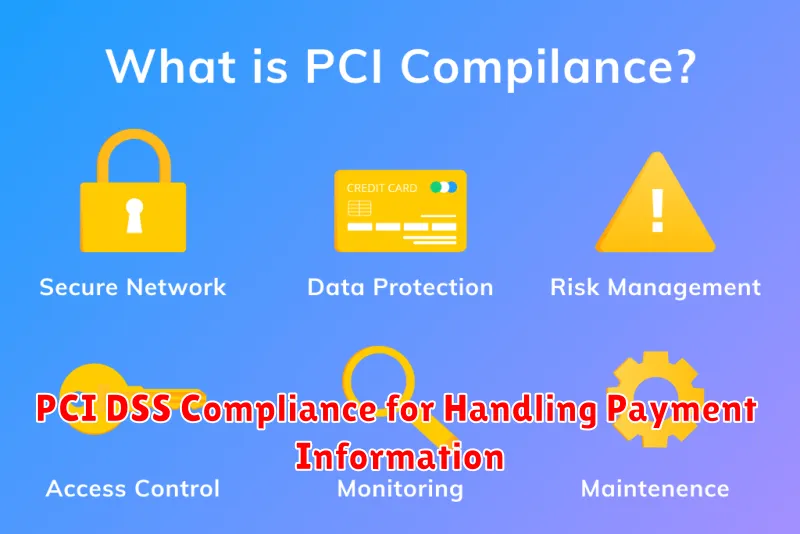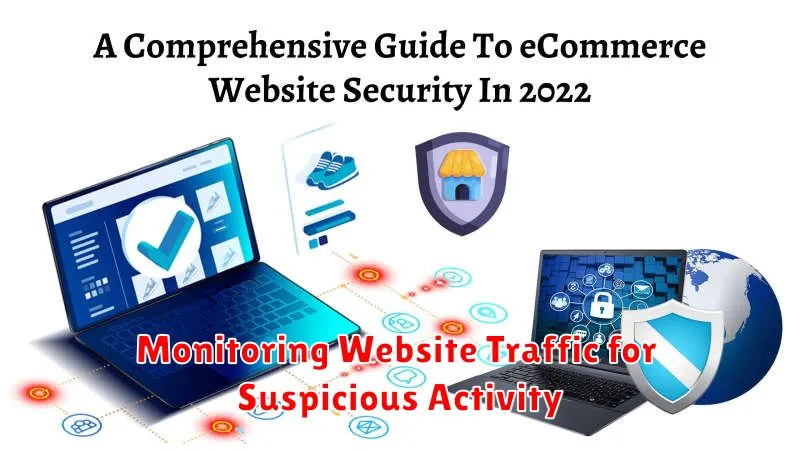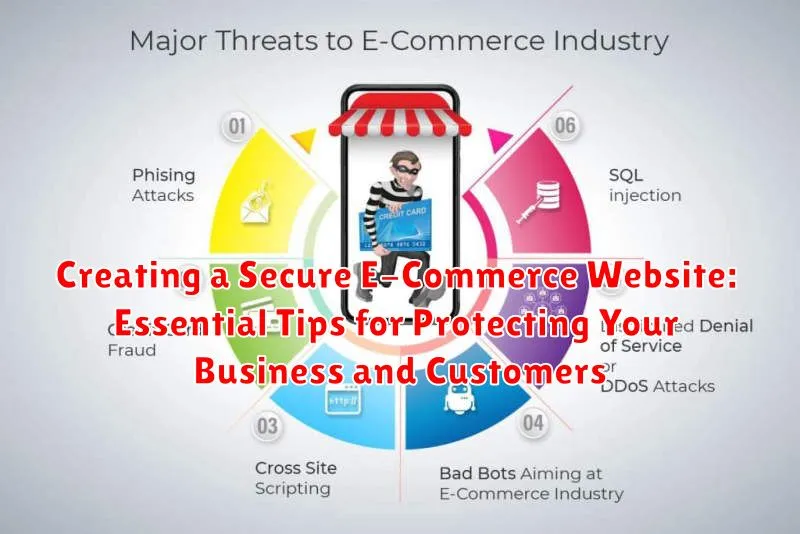In today’s digital landscape, a secure e-commerce website is no longer a luxury but a necessity. Creating a secure online store is paramount to building trust with customers, protecting sensitive data, and safeguarding your business from cyber threats. This article will delve into the essential tips for building a robust and secure e-commerce platform, covering everything from choosing the right platform and secure payment gateways to implementing SSL certificates and robust authentication measures. By following these guidelines, you can create a secure environment that fosters customer confidence and minimizes the risk of data breaches, fraud, and financial loss.
Protecting your e-commerce website and customer data requires a multi-faceted approach that encompasses various security measures. This article will provide you with practical advice and actionable steps to enhance your e-commerce security. Learn how to mitigate vulnerabilities, implement strong passwords, and educate your customers about safe online practices. From understanding the importance of regular security updates to implementing two-factor authentication, we will cover the crucial elements needed to fortify your online business and provide a secure and trustworthy shopping experience for your customers.
Implementing Secure Socket Layer (SSL) Encryption
SSL (Secure Sockets Layer), now commonly referred to as TLS (Transport Layer Security), is fundamental for e-commerce security. It encrypts the data transmitted between a customer’s browser and your website’s server, protecting sensitive information like credit card numbers, addresses, and login credentials from interception.
This encryption is visually indicated by a padlock icon in the browser’s address bar and the “https” prefix in the URL. Customers are more likely to trust and transact with a website displaying these security indicators.
Obtaining an SSL certificate is relatively straightforward. Many hosting providers offer them as part of their packages, or you can purchase one from a Certificate Authority (CA). Once obtained, the certificate must be installed and configured on your web server.
Ensuring your entire site is secured with HTTPS is crucial. This means redirecting all HTTP traffic to HTTPS and checking for any mixed content (HTTP resources loaded on an HTTPS page) that could compromise security.
Choosing a Secure E-Commerce Platform
Your e-commerce platform forms the foundation of your online store’s security. Choosing a secure platform is a critical first step in protecting your business and your customers. Look for platforms that prioritize security features and follow best practices.
Key factors to consider when selecting a platform include built-in security features like SSL certificates, PCI DSS compliance, and fraud prevention tools. A platform with a strong reputation for security is also essential. Research the platform’s history of security incidents and their responsiveness in addressing vulnerabilities.
Consider whether you need a self-hosted or hosted platform. Self-hosted platforms offer greater control over security but require more technical expertise. Hosted platforms often handle security updates and maintenance, simplifying the process for business owners.
Finally, ensure the platform supports regular security updates and patching. A platform that proactively addresses vulnerabilities is crucial for maintaining a secure online environment.
Protecting Against Common Web Vulnerabilities
Protecting your e-commerce website from common web vulnerabilities is crucial for maintaining a secure online environment. Cross-Site Scripting (XSS) attacks inject malicious scripts into web pages viewed by other users. Implement robust input validation and output encoding to prevent XSS vulnerabilities.
SQL Injection attacks exploit vulnerabilities in database queries to gain unauthorized access to sensitive data. Utilize parameterized queries or prepared statements to defend against SQL injection. Regularly scan your website for vulnerabilities using automated tools and conduct penetration testing to identify and address potential weaknesses.
Cross-Site Request Forgery (CSRF) attacks trick users into executing unwanted actions on a website in which they’re currently authenticated. Implement anti-CSRF tokens to mitigate this risk.
Using Strong Passwords and Authentication Methods
Strong passwords are the first line of defense against unauthorized access. Encourage customers and staff to create passwords that are long, complex, and unique. Passwords should include a mix of uppercase and lowercase letters, numbers, and symbols. Avoid easily guessed passwords like “password123” or personal information.
Implement multi-factor authentication (MFA) wherever possible. MFA adds an extra layer of security by requiring users to provide two or more forms of identification. This might include something they know (password), something they have (security token), or something they are (biometric verification). MFA makes it significantly more difficult for attackers to gain access even if they obtain a password.
Regularly update passwords. Establish a policy for both customer and administrative accounts requiring periodic password changes. Consider limiting password reuse to prevent a compromised password on one platform from affecting your e-commerce site.
Educate your team about password best practices and the importance of strong authentication. This training should cover topics like phishing scams and social engineering tactics that attackers use to steal credentials. Secure password management practices are crucial for protecting your business and customer data.
Regularly Updating Software and Security Patches
In the dynamic landscape of e-commerce security, staying ahead of vulnerabilities is paramount. Regularly updating your software and applying security patches is a fundamental practice for maintaining a secure online store.
Outdated software is a prime target for attackers. Known vulnerabilities in older versions can be exploited to gain unauthorized access to your systems and customer data. Promptly installing updates and patches closes these security gaps, significantly reducing your risk.
Establish a consistent update schedule for all software components, including your e-commerce platform, plugins, extensions, and server-side software. Enable automatic updates whenever possible to ensure you receive the latest security enhancements without delay.
Before deploying updates, particularly major ones, it’s advisable to back up your website. This precaution allows you to revert to a previous stable version should any unexpected issues arise during the update process.
PCI DSS Compliance for Handling Payment Information

The Payment Card Industry Data Security Standard (PCI DSS) is a critical security standard for any business that handles credit card information. Compliance protects your customers and your business from data breaches and fraud. Following these standards is not just a recommendation, it’s a requirement for accepting card payments.
PCI DSS compliance involves a multifaceted approach. Never store sensitive cardholder data unless absolutely necessary, and if you must, ensure it is encrypted according to PCI DSS guidelines. Use strong encryption protocols for all transactions and transmissions of cardholder data. Regularly test your security systems and processes, including vulnerability scans and penetration testing.
Working with a PCI DSS qualified security assessor can help simplify the compliance process. They can provide guidance on implementing security controls and validate your compliance efforts. Remember, maintaining PCI DSS compliance is an ongoing process, requiring continuous monitoring and updates to stay ahead of evolving threats.
Protecting Customer Data with Privacy Policies
A robust privacy policy is paramount for building trust and ensuring legal compliance. Clearly articulate how customer data is collected, used, stored, and protected. Transparency is key. Explain what types of data are collected (e.g., names, addresses, purchase history), the purpose of collection, and whether data is shared with third parties.
Data minimization is a crucial principle. Only collect the data necessary for business operations. Avoid collecting excessive information that isn’t essential for providing services. This minimizes the potential impact of data breaches.
Offer customers control over their data. Provide mechanisms for them to access, update, and delete their information. Consider implementing opt-in/opt-out choices for marketing communications and data sharing. Respecting customer preferences strengthens trust and reinforces your commitment to data privacy.
Monitoring Website Traffic for Suspicious Activity

Monitoring website traffic is crucial for identifying suspicious activity that could indicate a potential security breach. By proactively tracking and analyzing traffic patterns, you can detect and respond to threats before they escalate.
Implement a robust web application firewall (WAF) to filter malicious traffic and block known attack patterns. Regularly review WAF logs to identify and investigate unusual activity.
Utilize intrusion detection and prevention systems (IDPS) to monitor network traffic for suspicious behavior. These systems can automatically alert you to potential threats and even take action to block malicious activity.
Track key metrics such as login attempts, failed transactions, and access from unusual locations. Sudden spikes or anomalies in these metrics can indicate suspicious activity that warrants further investigation.
Regularly review server logs to identify unusual patterns or unauthorized access attempts. Pay close attention to access from unfamiliar IP addresses or unusual user agents.
Educating Employees on Security Best Practices
Employee training is a crucial aspect of e-commerce security. Regular security awareness programs can significantly reduce the risk of human error leading to breaches.
Focus on educating employees about password management, urging them to create strong, unique passwords and avoid sharing them. Explain the dangers of phishing emails and how to recognize and avoid them. Teach employees to identify and report suspicious activity, such as unusual login attempts or unrecognized devices accessing company systems.
Provide clear guidelines on data handling procedures. Employees must understand the importance of protecting customer information and follow established protocols for data access, storage, and disposal. This includes secure methods for handling sensitive data both electronically and physically.
Regularly update training materials to address new threats and reinforce best practices. Make security training an ongoing process to ensure employees remain vigilant and informed about the evolving cybersecurity landscape.

